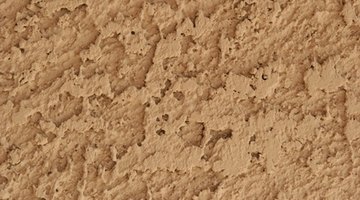How to Spray Drywall Texture With an Airless Sprayer
Textured walls and ceilings hide imperfections in the drywall beneath and add a decorative element to the room. While you can apply texture to a wall with rollers, rags and brushes, the quickest way to do the job is with an airless sprayer. Using diluted drywall compound and a sprayer designed to accommodate the thick liquid, you can add uniform texture to your wall.

-
Sand off leftover globs of drywall compound on the walls and fill large nail holes and dings with putty. Drywall texture hides small imperfections, but large ones may show through.
-
Roll the walls or ceiling with a coat of thinned drywall compound, using a paint roller. If you're coloring the texture, roll the walls with a fresh coat of matching paint.
-
Drape floors, cabinets and another other furniture or items with dropcloths to prevent overspray.
-
Dilute the drywall compound with water at the ratio suggested on the machine. Trying to run a thicker compound through the airless sprayer than recommended can result in clogging and uneven texture.
-
Add paint now, if desired, to the diluted drywall compound. If you're spraying a large area, note the exact amount of paint you add to the compound so you can reproduce the shade in the next batch.
-
Test the texture spray on a large scrap board or piece of drywall. Use a sweeping, side-to-side motion. If the texture is too heavy, tighten the nozzle slightly on the spray gun. If the texture is too light, loosen the nozzle. When you get the look you want on the test board, write down the nozzle adjustment number for later reference.
-
Begin in an upper corner of your wall and use the same strokes you used on your test board. Work from the top down, going across the wall and then working downward. If you're texturing a ceiling, start in one corner and move sideways across the edge of the ceiling and then from side to side, on the rest of the ceiling. Avoid moving the sprayer up and down or in a circular motion, which may alter your pattern.
-
Repeat with each wall, doing only one wall at a time and completing an entire wall before moving to the next one. Allow the texture to dry completely.
References
Resources
Tips
- To spray on drywall texture, you'll need a little bit more power than a regular airless sprayer that disperses paint or lacquer. Drywall texture is thick and commercial airless spray rigs are expensive. Rent a texture sprayer from a construction rental store if you're only going to use it on a single job.
- Some airless texture sprayers have an attached hopper that holds the drywall compound. Others have a hose that pumps the compound out of a bucket and through the sprayer. If you're using one with a hopper, recruit an assistant to keep adding compound to the hopper while you spray for a continuous, even effect.
Warnings
- Wear protective clothing and eyewear.
Writer Bio
Glenda Taylor is a contractor and a full-time writer specializing in construction writing. She also enjoys writing business and finance, food and drink and pet-related articles. Her education includes marketing and a bachelor's degree in journalism from the University of Kansas.
Photo Credits
- stucco texture image by MAXFX from Fotolia.com
More Articles



